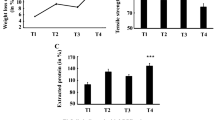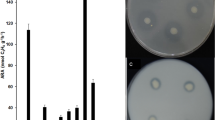Abstract
Biofertilizer happens to be a promising alternative of chemical fertilizer in the establishment of sustainable agricultural practices. Following this observation, several nitrogen-fixing bacteria were isolated from the soil in which an isolate (AKS7) was selected for further studies as AKS7 showed considerable competence in growth on nitrogen-free growth medium. Acetylene reduction assay confirmed that AKS7 can fix atmospheric nitrogen efficiently. The result of Kjeldahl assay revealed that the organism (AKS7) could fix nitrogen up to 12 mg in 8 days. A strong positive correlation (r = 0.987) was observed between microbial cell biomass and the amount of nitrogen fixed by AKS7 over a period of 8 days. The organism was identified as Enterobacter cloacae through molecular and biochemical tests. To investigate the in situ nitrogen fixation by E. cloacae AKS7, naturally attenuated (AKS7 not-inoculated) and bioaugmented (AKS7-inoculated) soil microcosms were prepared. The bioaugmented microcosm showed higher level of soil nitrogen content than naturally attenuated microcosm. A large number of heterotrophic as well as nitrogen-fixing microorganisms were counted in bioaugmented microcosm than naturally attenuated microcosm. Results of the carbon source utilization patterns of BiOLOG ECO plate revealed that bioaugmented microcosm exhibited higher level of functional richness and evenness that lead to the exhibition of higher level of microbial functional-diversity in bioaugmented microcosm than the naturally attenuated microcosm. Taken together, the results indicated that augmentation of E. cloacae AKS7 into soil enhanced the nitrogen content and soil microbial functional-diversity considerably.



Similar content being viewed by others
References
Adam G, Duncan H (2001) Development of a sensitive and rapid method for the measurement of total microbial activity using fluorescein diacetate (FDA) in a range of soils. Soil Biol Biochem 33:943–951
Alef K, Nannipieri P (1995) Methods in applied soil microbiology and biochemistry. Academic Press, London
APHA (2005) Standard methods for the examination of water and wastewater. American Public Health Association, Washington DC
Ausubel FM, Brent R, Kingston RE, Moore DD, Seidman JG, Smith JA, Struhl K (1994) Current protocols in molecular biology. Wiley, New York
Bardi L, Malusà E (2012) Drought and nutritional stresses in plant: alleviating role of rhizospheric microorganisms. Abiotic stress: new research. Nova Science Publishers Inc., Hauppauge, pp 1–57
Bhardwaj D, Ansari MW, Sahoo RK, Tuteja N (2014) Biofertilizers function as key player in sustainable agriculture by improving soil fertility, plant tolerance and crop productivity. Microb Cell Fact 13(1):66
Chakraborty P, Tribedi P (2019) Functional diversity performs a key role in the isolation of nitrogen-fixing and phosphate-solubilizing bacteria from soil. Folia Microbiol (Praha). https://doi.org/10.1007/s12223-018-00672-1 (Epub ahead of print)
Choi KH, Dobbs FC (1999) Comparison of two kinds of BiOLOG microplates (GN and ECO) in their ability to distinguish among aquatic microbial communities. J Microbiol Methods 36:203–213
Clark CM, Flynn DF, Butterfield BJ, Reich PB (2012) Testing the link between functional diversity and ecosystem functioning in a Minnesota grassland experiment. PLoS One 7:e52821
Dilworth MJ (1966) Acetylene reduction by nitrogen-fixing preparations from Clostridium pasteurianum. Biochim Biophys Acta 127:285–294
Dubey RC, Maheshwari DK (2012) Practical microbiology, 5th edn. S. Chand Publishing, New Delhi (ISBN: 9788121921534)
Epelde L, Mijangos I, Becerril JM, Garbisu C (2009) Soil microbial community as bioindicator of the recovery of soil functioning derived from metal phytoextraction with sorghum. Soil Biol Biochem 41:1788–1794
Glick BR (2012) Plant growth promoting bacteria: mechanisms and applications. Scientifica 2012:15
Gu Y, Wag P, Kong C (2009) Urease, invertase, dehydrogenase and polyphenoloxidase activities in paddy soils influenced by allelophatic rice variety. Eur J Soil Biol 45:436–441
Hoffman BM, Dean DR, Seefeldt LC (2009) Climbing nitrogenase: toward a mechanism of enzymatic nitrogen fixation. Acc Chem Res 42:609–619
Jetiyanon K, Pliabanchang P (2012) Potential of Bacillus cereus strain RS87 for partial replacement of chemical fertilisers in the production of Thai rice cultivars. J Sci Food Agric 92:1080–1085
Kayasth M, Gera R, Dudeja SS, Sharma PK, Kumar V (2014) Studies on salinization in Haryana soils on free-living nitrogen-fixing bacterial populations and their activity. J Basic Microbiol 54:170–179
Kessler PS, Leigh JA (1999) Genetics of nitrogen regulation in Methanococcus maripaludis. Genetics 152:1343–1351
Kumar S, Stecher G, Tamura K (2016) MEGA7: molecular evolutionary genetics analysis version 7.0 for bigger datasets. Mol Biol Evol 33:1870–1874
Mahanty T, Bhattacharjee S, Goswami M, Bhattacharyya P, Das B, Ghosh A, Tribedi P (2017) Biofertilizers: a potential approach for sustainable agriculture development. Environ Sci Pollut Res Int 24:3315–3335
Malusa E, Vassilev N (2014) A contribution to set a legal framework for biofertilisers. Appl Microbiol Biotechnol 98:6599–6607
Mason NW, Mouillot D, Lee WG, Wilson JB (2005) Functional richness, functional evenness and functional divergence: the primary components of functional diversity. Oikos 111:112–118
Mazid M, Khan TA (2015) Future of bio-fertilizers in Indian agriculture: an overview. Int J Agric Food Res 3:10–23
Park M, Kim C, Yang J, Lee H, Shin W, Kim S, Sa T (2005) Isolation and characterization of diazotrophic growth promoting bacteria from rhizosphere of agricultural crops of Korea. Microbiol Res 160:127–133
Salazar S, Sanchez L, Alvarez J, Valverde A, Galindo P, Igual J, Peix A, Santa-Regina I (2011) Correlation among soil enzyme activities under different forest system management practices. Ecol Eng 37:1123–1131
Singh J, Singh DK (2005) Dehydrogenase and phosphomonoesterase activities in groundnut (Arachis hypogaea L.) field after diazinon, imidacloprid and lindane treatments. Chemosphere 60:32–42
Smith BE, Richards RL, Newton WE (eds) (2013) Catalysts for nitrogen fixation: nitrogenases, relevant chemical models and commercial processes, vol 1. Springer, Berlin, p 340
Tribedi P, Sil AK (2013) Bioaugmentation of polyethylene succinate contaminated soil with Pseudomonas sp. AKS2 results in increased microbial activity and better polymer degradation. Environ Sci Pollut Res Int 20:1318–1326
Tribedi P, Sarkar S, Mukherjee K, Sil AK (2012) Isolation of a novel Pseudomonas sp. from soil that can efficiently degrade polyethylene succinate. Environ Sci Pollut Res Int 19:2115–2124
Acknowledgements
The authors’ would like to express sincere gratitude to the learned experts for their immense guidance and cooperation in improving the manuscript. We sincerely thank Ms. Rakshita Dave and Ms. Sutirtha Dutta for their help in correcting the language of the manuscript. This current work was supported by a grant in aid from the Department of Science and Engineering research board (SERB), DST, Govt. of India (Sanction number: YSS/2015/000387). Reagents like fluorescein diacetate (FDA) and 2,3,5-triphenyl tetrazolium chloride (TTC) were received as a kind gift from Dr. Alok Kumar Sil (Department of Microbiology, University of Calcutta) and Mr. Tapan Saha (Institute of Environmental Studies and Wetland Management, Kolkata), respectively.
Author information
Authors and Affiliations
Corresponding author
Ethics declarations
Conflict of interest
Authors’ declare that they do not have any conflict of interest.
Electronic supplementary material
Below is the link to the electronic supplementary material.
Rights and permissions
About this article
Cite this article
Chakraborty, P., Sarker, R.K., Roy, R. et al. Bioaugmentation of soil with Enterobacter cloacae AKS7 enhances soil nitrogen content and boosts soil microbial functional-diversity. 3 Biotech 9, 253 (2019). https://doi.org/10.1007/s13205-019-1791-8
Received:
Accepted:
Published:
DOI: https://doi.org/10.1007/s13205-019-1791-8




